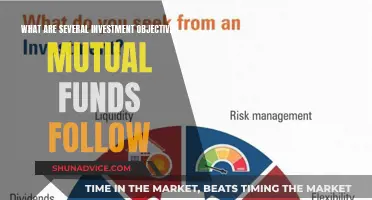
Investing $50,000 can be both exhilarating and intimidating, especially for those new to the world of finance. There are many options to consider, including paying off high-interest debt, setting aside money for savings, contributing to a 401(k) or IRA, investing with a brokerage or robo-advisor account, and investing in a child's future. It's important to understand your financial goals, risk tolerance, and time frame before making any investment decisions.
| Characteristics | Values |
|---|---|
| Investment Type | Mutual Funds |
| Investment Options | Stocks, bonds, exchange-traded funds (ETFs), commodities, real estate investment trusts (REITs), cryptocurrencies |
| Investment Accounts | Brokerage account, individual retirement account (IRA), health savings account (HSA), 529 college savings plan, custodial account (UTMA/UGMA), education savings account (ESA) |
| Investment Strategies | Buy-and-hold, robo-advisor, financial advisor |
| Risk Level | Moderate to high |
| Returns | Moderate to high |
What You'll Learn

Invest in stocks, bonds, ETFs, or mutual funds through a brokerage account
If you have $50,000 to invest, you'll need a brokerage account to access stocks, bonds, ETFs, or mutual funds. A brokerage account is a special type of financial account that allows you to contribute money to buy-and-hold investments.
There are several brokerage firms to choose from, each with slightly different features. Some are rather minimalist, catering to investors who simply want a place to buy and sell stocks. Others offer features such as sophisticated trading platforms, educational resources, and fully functional mobile apps. It's a good idea to compare several of the top brokerages to see which one best meets your needs.
Here's a breakdown of the investment options available through a brokerage account:
Stocks
Stocks, also known as shares of stock, are a way for companies to raise money. When you buy a stock, you essentially own a piece of a company, and the value of your stock is tied to the company's financial performance. Stocks are considered high-risk investments, as there is no guarantee that their value will increase over time. However, they can help diversify your investment portfolio.
Bonds
Bonds are debt investments or loans made to companies or governments. When you purchase a bond, you are loaning money to the bond issuer, who agrees to pay back the principal (the loan amount) plus interest over a specified time frame. Most bonds are designed to pay a steady income, known as the "coupon rate," on a regular basis. While bonds are generally considered less risky than stocks, there is still a risk of default, where the issuer may not be able to pay back the principal.
Mutual Funds
Mutual funds are baskets of investments, chosen and managed by professionals. When you invest in a mutual fund, you own shares of the fund, which in turn owns a diverse range of individual securities, such as stocks and bonds, from different segments of the market or various industries. Mutual funds can be actively managed, where fund managers aim to beat a benchmark index, or passively managed, where they try to match the performance of an index. Mutual funds charge an expense ratio, which is a fee deducted from your investment, to cover management costs.
ETFs (Exchange-Traded Funds)
Like mutual funds, ETFs (or Exchange-Traded Funds) are baskets of securities that can include a mix of stocks, bonds, commodities, and other assets. ETFs can be actively managed or passively managed as index funds, which aim to mirror the performance of a market index. ETFs are traded on major stock exchanges, and you choose how many shares of a particular ETF you want to buy. They tend to have lower expense ratios than mutual funds, making them a popular investment choice.
When deciding how to allocate your $50,000, it's important to understand the concept of asset allocation, or how you diversify your investment portfolio across different asset classes. Instead of investing all your money in a single asset, spreading it across multiple assets can help reduce your risk.
Retirement Mutual Funds: Choosing the Right Investment for Your Future
You may want to see also

Consider a Health Savings Account (HSA)
A Health Savings Account (HSA) is a tax-advantaged account that can be used to pay for qualified medical expenses, including copays, prescriptions, dental care, contacts and eyeglasses, bandages, X-rays, and more. It is typically paired with an HSA-eligible health plan, which is a high-deductible health plan (HDHP).
There are several benefits to opening an HSA:
- Your contributions reduce your taxable income, and the money isn't taxed while it's in the account, even if it earns interest or investment returns.
- Distributions from an HSA are tax-free, provided that the funds are used for qualified medical expenses.
- You can also invest the money in your HSA in stocks and other securities, potentially allowing for higher returns over time.
- You can carry forward unused contributions to the following year.
- The account is portable, meaning that if you change jobs, you can still keep your HSA.
- There are no required minimum distributions (RMDs) for HSAs, unlike 401(k)s and traditional IRAs.
However, there are also some drawbacks and requirements to consider:
- You need to be enrolled in an HSA-eligible HDHP, have no other health coverage, not be enrolled in Medicare, and not be claimed as a dependent on someone else's tax return.
- You need to be able to afford the high deductibles and benefit from the tax advantages.
- There are regulatory filing requirements regarding contributions, withdrawals, distribution reporting, and other factors, which create a record-keeping burden.
- If you use HSA funds for anything other than a qualified medical expense, that amount is subject to income tax and an additional 20% tax penalty (unless you are 65 or older, in which case only income tax applies).
For 2024, the contribution limit for an HSA is $4,150 for an individual and $8,300 for a family. Individuals age 55 or older can make catch-up contributions of an additional $1,000.
Short-Term Investment Strategies: Where to Invest Your Money
You may want to see also

Invest in an index fund
Index funds are a great investment option for building wealth over the long term. They are a group of stocks that mirror the performance of an existing stock market index, such as the S&P 500. Index funds don't try to beat the market but instead aim to be the market by buying stocks of all firms listed on a particular market index. This passive management strategy helps balance the risk in an investor's portfolio as market swings tend to be less volatile across an index compared to individual stocks.
Research and analyze index funds:
Consider the geographic location, market sector, and market opportunity of the index fund. Evaluate what each fund is investing in and understand the potential opportunities and risks.
Decide which index fund to buy:
Compare the expenses, taxes, and investment minimums of each fund. Look for funds with low expense ratios, as these fees can impact your long-term returns. Also, consider the long-run performance of the fund and the underlying index it tracks.
Purchase your index fund:
You can buy an index fund directly from a mutual fund company or through a broker. Mutual funds may have higher transaction fees, so consider using a discount broker or purchasing an ETF, which trades like stocks and often has lower fees.
Keep an eye on your index funds:
Monitor the performance of your index fund to ensure it mirrors the underlying index. Be mindful of increasing fees, and consider reevaluating your investment if the fund consistently underperforms the index.
Index funds are a popular choice for investors because they offer attractive returns, immediate diversification, lower risk, and low costs. They are a great option for beginners as they don't require extensive knowledge of financial markets. By investing in an index fund, you can participate in the overall growth of the economy and build your wealth over time.
Negative-Yield Bond Investment: Why Do Funds Take the Risk?
You may want to see also

Invest with a robo-advisor
Robo-advisors are digital platforms that provide automated, algorithm-driven financial planning and investment services with little to no human intervention. They are best suited for traditional investing and are not the best option for more complex issues such as estate planning.
Robo-advisors are often inexpensive and require low opening balances, making them available to retail investors. They are efficient, and with robo-advisors, it's generally easier to keep tabs on your investments.
Robo-advisors can be a good option if you have a small account and limited investment experience. However, they may not be the best choice if you need services like estate planning, complicated tax management, trust fund administration, and retirement planning.
- Wealthfront: Best Overall, Best for Goal Planning, Best for Portfolio Construction, and Best for Portfolio Management
- Betterment: Best for Beginners, Best for Cash Management, Best for Tax-Loss Harvesting, and Best for Crypto Portfolio Selection
- SoFi Automated Investing: Best for Low Costs
- M1 Finance: Best for Sophisticated Investors
- Acorns: Best for Those Who Struggle to Save
- Ellevest: Best for Women Investors
- ETRADE Core Portfolios: Best for Mobile
- Merrill Guided Investing: Best for Education
Hedge Fund Insights: EDGAR Investment Info Source
You may want to see also

Pay off high-interest debt
If you have $50,000 to invest, it is important to first consider your current financial situation. For example, if you have high-interest debt, it is advisable to use some or all of the $50,000 to pay it off. Credit card debt can be particularly burdensome, with high interest rates and large monthly payments that can impact your financial stability.
One option to tackle high-interest debt is to negotiate with your credit card company. Credit card companies are often willing to work with borrowers to create a repayment plan that helps eliminate the debt. You can call the number on the back of your credit card and ask to speak to a representative in the debt settlement department to discuss your options. Some companies may accept a smaller sum if you can pay it upfront, or they may reduce your interest rate for a specific period.
Another strategy is to use a balance transfer credit card, which can eliminate high APRs for a set period. These cards are designed to facilitate the transfer of credit card debt from one card to another, often with an introductory 0% APR for balance transfers. For example, the Wells Fargo Reflect® Card offers 21 months of 0% APR for balance transfers. However, these cards often impose balance transfer fees, usually around 3-5% of the total transfer.
Alternatively, you could consider a debt consolidation loan, which combines multiple credit card balances into one loan with a lower APR. This can help you save on interest and put more money towards the principal debt.
While tackling high-interest debt may not be a traditional investment strategy, it can be one of the best ways to invest in your future and improve your financial situation. By eliminating high-interest debt, you can free up more of your income to put towards other financial goals and investments.
Strategies for Funding a 20% Down Payment on Investment Property
You may want to see also
Frequently asked questions
The best way to invest 50k depends on your financial goals, risk tolerance, and time horizon. Some options include paying off debt, investing in stocks, bonds, real estate, or cryptocurrencies, or contributing to a retirement account. It's important to do your research and carefully consider the risks and potential returns of each investment option before making a decision.
The interest earned on 50k depends on the investment vehicle and its rate of return. For example, investing in a high-yield savings account with a 4% annual percentage yield (APY) would result in approximately 2,000 in interest over one year. Investing in an S&P 500 index fund with a 24% return would result in 12,000 in interest on a 50k investment.
Mutual funds offer diversification, professional management, and the potential for higher returns. By pooling your money with other investors, you can access a wider range of stocks, bonds, and other investments. Mutual funds are actively managed by professionals who allocate the portfolio on your behalf, taking the need for research and individual stock risk out of the equation. While there are no guarantees, mutual funds have the potential to outperform the market and provide higher returns over time.







